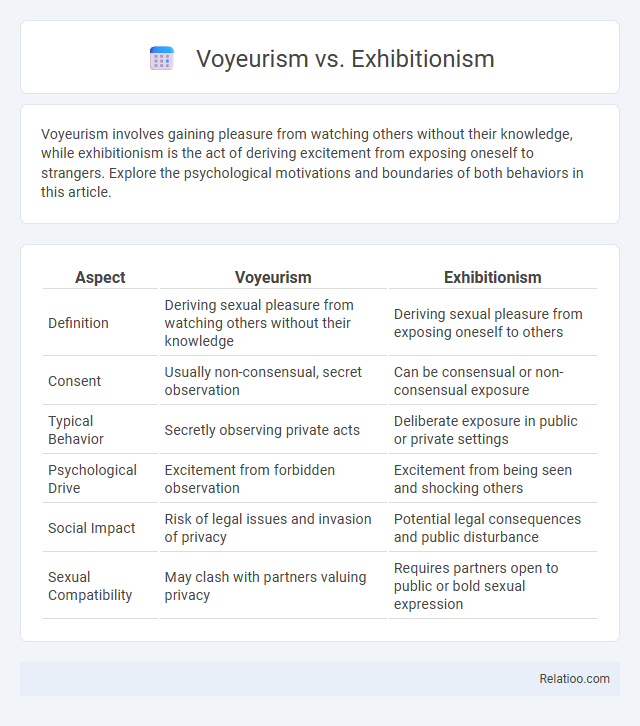Voyeurism involves gaining pleasure from watching others without their knowledge, while exhibitionism is the act of deriving excitement from exposing oneself to strangers. Explore the psychological motivations and boundaries of both behaviors in this article.
Table of Comparison
| Aspect | Voyeurism | Exhibitionism |
|---|---|---|
| Definition | Deriving sexual pleasure from watching others without their knowledge | Deriving sexual pleasure from exposing oneself to others |
| Consent | Usually non-consensual, secret observation | Can be consensual or non-consensual exposure |
| Typical Behavior | Secretly observing private acts | Deliberate exposure in public or private settings |
| Psychological Drive | Excitement from forbidden observation | Excitement from being seen and shocking others |
| Social Impact | Risk of legal issues and invasion of privacy | Potential legal consequences and public disturbance |
| Sexual Compatibility | May clash with partners valuing privacy | Requires partners open to public or bold sexual expression |
Defining Voyeurism and Exhibitionism
Voyeurism involves deriving sexual pleasure from secretly observing others without their knowledge, while exhibitionism centers on exposing one's body or sexual acts to unsuspecting viewers to gain arousal. Your understanding of these behaviors is crucial for recognizing boundaries and consent in intimate or public settings. Fetish differs by focusing on specific objects or body parts as sources of sexual excitement, rather than the act of observing or displaying.
Psychological Roots of Voyeurism
Voyeurism stems from psychological roots involving a desire for control, thrill, and gratification by observing others without their consent, often linked to underlying issues of insecurity or repression. Exhibitionism involves the urge to expose oneself to gain attention and validation, reflecting a need for dominance or affirmation of identity. Fetishism centers on a fixation with specific objects or body parts that serve as a primary source of sexual arousal, highlighting complex conditioning and psychological associations. Understanding these distinctions can help you explore the motivations behind these behaviors more clearly.
Psychological Roots of Exhibitionism
Exhibitionism stems from deep psychological roots tied to the need for validation and control, often linked to issues of self-esteem and power dynamics. Unlike voyeurism, which involves deriving pleasure from watching others without their knowledge, exhibitionism is characterized by the urge to display one's body or actions to unsuspecting observers for sexual gratification. Your understanding of these behaviors can be enhanced by exploring their connections to early childhood experiences and the complex interplay of arousal, taboo, and vulnerability.
Legal Perspectives and Consequences
Voyeurism involves secretly observing others without consent, often leading to criminal charges such as invasion of privacy or unlawful surveillance. Exhibitionism, characterized by exposing oneself to unwilling recipients, is typically prosecuted under indecent exposure laws with potential jail time and sex offender registration. Fetishism, when involving consenting adults and no harm, is generally legal, but engaging non-consensual acts or involving minors triggers severe legal consequences that can affect your personal and professional life.
Social Attitudes and Cultural Stigma
Social attitudes toward voyeurism, exhibitionism, and fetish vary widely, often shaped by cultural norms and legal boundaries that influence public perception and stigma. Voyeurism and exhibitionism are generally viewed negatively due to privacy violations and public indecency concerns, whereas fetishes, unless harmful or non-consensual, are increasingly recognized as part of sexual diversity. Understanding these distinctions can help you navigate societal judgments and promote a more informed and respectful dialogue around diverse sexual behaviors.
Voyeurism and Exhibitionism in Media
Voyeurism and exhibitionism are frequently portrayed in media, often blurring the line between consensual and invasive behaviors. Voyeurism involves secretly observing others without their knowledge, creating tension and intrigue in films and television through hidden cameras or spying narratives. Exhibitionism, by contrast, centers on the desire to be seen or to display oneself, frequently explored in media to examine themes of vulnerability, attention-seeking, or social boundaries.
Consent and Ethical Boundaries
Voyeurism involves gaining sexual pleasure from observing others without their consent, violating ethical boundaries and personal privacy. Exhibitionism entails exposing oneself to unsuspecting individuals, breaching consent and creating discomfort or harm. Fetishism centers on consensual attraction to specific objects or body parts, emphasizing the importance of mutual consent and respect within ethical sexual practices.
Impacts on Mental Health
Voyeurism, exhibitionism, and fetish each present unique challenges to mental health, often rooted in underlying psychological dynamics. Voyeurism can lead to anxiety and guilt due to privacy violations, while exhibitionism may result in social isolation from inappropriate public behavior. Fetishes, depending on their nature and social acceptance, can either provide comfort or cause distress when interfering with daily life or relationships, impacting Your emotional well-being.
Treatment and Support Options
Treatment and support options for voyeurism, exhibitionism, and fetish often involve cognitive-behavioral therapy to address underlying psychological issues and modify problematic behaviors. You may benefit from specialized counseling, support groups, and sometimes pharmacotherapy such as SSRIs to manage compulsive tendencies and improve impulse control. Tailored interventions based on individual assessment enhance recovery outcomes and promote healthier expressions of sexuality.
Preventive Strategies and Education
Preventive strategies for voyeurism, exhibitionism, and fetish behaviors center on comprehensive sexual education emphasizing consent, boundaries, and respectful interactions. Early interventions include cognitive-behavioral therapy and community awareness programs to reduce risky behaviors and promote emotional regulation. Educating individuals about the legal consequences and psychological impacts fosters responsible sexual expression and minimizes harm.

Infographic: Voyeurism vs Exhibitionism
 relatioo.com
relatioo.com